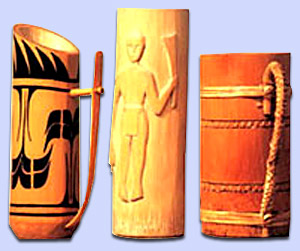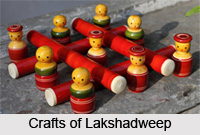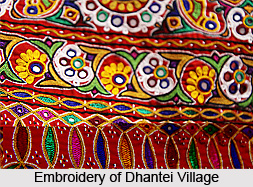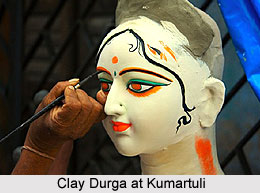 After undergoing through several changes, art and crafts in West Bengal, the state has now emerged with an artistic diversity in the forms of traditional handicrafts, masks, painting and carving, dance, music etc. Among these, clay crafts are the most ancient and traditional form of art in the state. The artisans create different items out of clay and to give them a distinct style and lustre a lot of techniques are followed by the artisans. The craftsmen involved in clay crafts usually follow two separate forms. One of the forms is the terracotta one in which the figurines are burnt to get the desired hardness and the other one is that does not follow the method of burning the clay items. This second process is more prevalent in Kumartuli and the city of Krishnanagar in West Bengal.
After undergoing through several changes, art and crafts in West Bengal, the state has now emerged with an artistic diversity in the forms of traditional handicrafts, masks, painting and carving, dance, music etc. Among these, clay crafts are the most ancient and traditional form of art in the state. The artisans create different items out of clay and to give them a distinct style and lustre a lot of techniques are followed by the artisans. The craftsmen involved in clay crafts usually follow two separate forms. One of the forms is the terracotta one in which the figurines are burnt to get the desired hardness and the other one is that does not follow the method of burning the clay items. This second process is more prevalent in Kumartuli and the city of Krishnanagar in West Bengal.
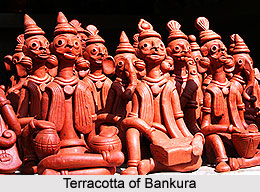 Clay Dolls: The craft of doll making is practised by many in the Krishnanagar area of the Nadia district. These dolls have been customarily crafted by women from the potter communities and are made of soft clay and fired-clay, which is available all over West Bengal. Each of these dolls is unique in their own way and is made differently. It was during the late 18th century, under the patronage of Maharaja Krishna Chandra that the tradition of clay image making started. As a pioneer who started Kali Puja and Jagadhatri Puja for the first time in Bengal, he encouraged the local artisans and brought in potters from Dhaka and Natore districts of West Bengal to a neighbourhood in Krishnanagar called Ghurni. The clay dolls of Ghurni play an important role in the export market of decorative products. It is said that the Krishnanagar clay dolls have won medals and certificates and have received great admiration from the Europeans. The industry of clay dolls have flourished in different villages of the state according to the local need of that particular area. The exquisite craftsmanship of these artisans have earned them laurels and accolades from the British royalty like Queen Victoria as well as other foreign dignitaries during the British Empire and Catholic Popes in recent times.
Clay Dolls: The craft of doll making is practised by many in the Krishnanagar area of the Nadia district. These dolls have been customarily crafted by women from the potter communities and are made of soft clay and fired-clay, which is available all over West Bengal. Each of these dolls is unique in their own way and is made differently. It was during the late 18th century, under the patronage of Maharaja Krishna Chandra that the tradition of clay image making started. As a pioneer who started Kali Puja and Jagadhatri Puja for the first time in Bengal, he encouraged the local artisans and brought in potters from Dhaka and Natore districts of West Bengal to a neighbourhood in Krishnanagar called Ghurni. The clay dolls of Ghurni play an important role in the export market of decorative products. It is said that the Krishnanagar clay dolls have won medals and certificates and have received great admiration from the Europeans. The industry of clay dolls have flourished in different villages of the state according to the local need of that particular area. The exquisite craftsmanship of these artisans have earned them laurels and accolades from the British royalty like Queen Victoria as well as other foreign dignitaries during the British Empire and Catholic Popes in recent times.
Clay Pottery: An ancient craft in India, the art of clay pottery has a unique tempting appeal. Bengal archaeological finds in Pandu Rajar Dhibi and elsewhere have proved that a high degree of skill and excellence was achieved by Bengal potters in those ancient days. For years, the traditional potters known as Kumbhakars have been working on their wheels in the villages of West Bengal and have been turning out numerous items of clay products to cater the domestic and religious needs of the community. The art of pottery making is a well refined and established culture in almost every village in West Bengal but among these villages, the district of Bankura has been recognized across the world for its clay ware. Made with rich alluvial clay from the river banks of West Bengal, the terracotta horse of Bankura is an excellent example of such craft. The method of manufacturing these horses is quite simple in nature. The kumbhakars use the rustic clay shaping, furnace and drying methods before giving it a final touch. In addition to the Bankura horses, there are fine qualities of food plates, containers and pots produced here. The terracotta temples in the districts of Murshidabad, Bishnupur and Midnapore stands as exemplary examples of artistry of the Bengal sculptors which provides a glimpse of an outstanding stature of Bengal pottery that goes beyond the conventional clay-ware present elsewhere in the country.
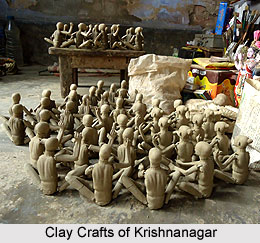 Clay Art of Kumartuli: The idol making industry established in the remote region of Kumartuli is one such art that exemplifies the Bengali creativity. The artisans here, also known as karigars, craft and embellish images of popular Gods and Goddesses that are deeply embedded into the Bengali culture. The process of idol making can be divided into three stages. First, the artisans make the framework with bamboo and tie them up with dried straw to create the basic structure. This is followed by applying clay and painting the structure. Lastly, the karigar decorates the clay images by incorporating a mixture of the traditional and modernized themes. The craftsmen are engaged in idol making throughout the year and the real fervour and intensity of idol making is apparent during the autumnal period when the Bengalis celebrate their Durga Puja. As Durga Puja is a celebration of defeat of evil over virtuousness, thematic puja idols are created to spread social consciousness amongst the visitors.
Clay Art of Kumartuli: The idol making industry established in the remote region of Kumartuli is one such art that exemplifies the Bengali creativity. The artisans here, also known as karigars, craft and embellish images of popular Gods and Goddesses that are deeply embedded into the Bengali culture. The process of idol making can be divided into three stages. First, the artisans make the framework with bamboo and tie them up with dried straw to create the basic structure. This is followed by applying clay and painting the structure. Lastly, the karigar decorates the clay images by incorporating a mixture of the traditional and modernized themes. The craftsmen are engaged in idol making throughout the year and the real fervour and intensity of idol making is apparent during the autumnal period when the Bengalis celebrate their Durga Puja. As Durga Puja is a celebration of defeat of evil over virtuousness, thematic puja idols are created to spread social consciousness amongst the visitors.
The clay crafts of West Bengal are the unique instances of the rich cultural heritage of west Bengal and the artisans have been living on this crafts for generations. Apart from creating deities and utilitarian items the craftsmen create different decorative items with discernable variations and artistry.



